Antique W. Watson & Sons Edinburgh Mono/Binocular Brass Microscope c1900, Cased
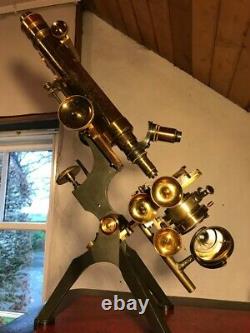
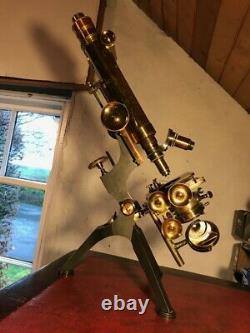
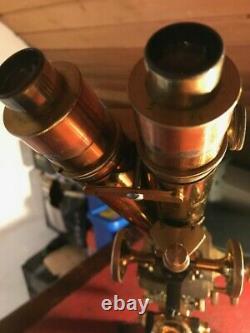
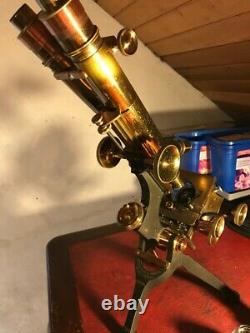
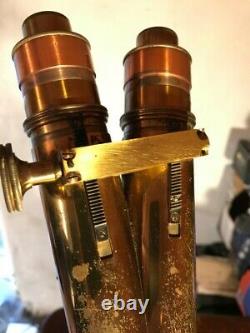
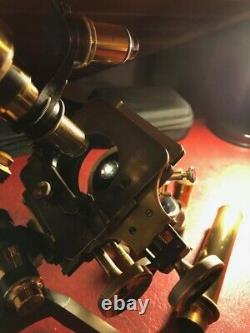


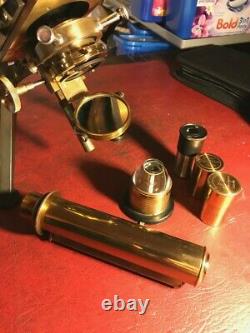
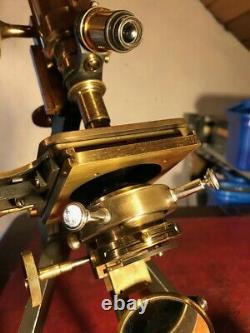
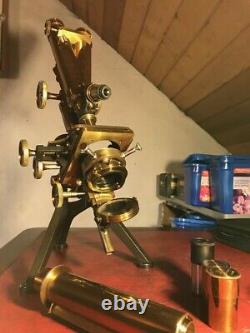
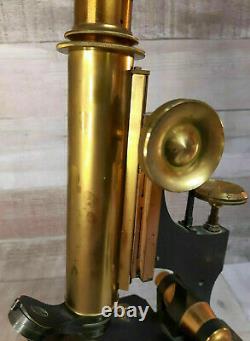

Undergoing Preparation & Testing - Further Photos to Follow. This listing is for a rather nice example of an antique Edinburgh Student's microscope in brass by W. Watson & Sons Limited of London. It dates from around 1900 based on the sequential Watson production number of 5314, which is engraved onto the frame, just above the rear tripod foot. It's configuration suggests that this example is an Edinburgh F or H model.
Watson produced the Edinburgh stand between 1887 and around 1945; its long production run giving us a firm clue regarding just how good this model of microscope was in its heyday. This example was originally retailed by Watson agents J. Woolley & Sons of Manchester, according to an engraving on the instrument's rear brass cross-member. The Edinburgh stand design was originally developed by Watson in collaboration with a professor and lecturer in bacteriology at the University of Edinburgh and was used on a number of different Watson models in this period.
This example is pretty unique in my experience because it's supplied with the Wenham binocular option in addition to its standard tube (shown in final listing photo) and it's also fitted with a double nose-piece, making an imposing visual treat, especially when its brass-work catches the light. This Edinburgh stand is essentially. An excellent piece of British optical engineering showing its quality from every one of its many intricate parts, based on good materials, solid construction, great design and skilled workmanship with plenty of hand-finishing of components carried out in this period.Have a detailed look at the quality of the construction, even the brass screws and other furniture really do scream top quality from every part. This is therefore a sturdy, well-made antique microscope in really good original condition with some sympathetic additions. It's fully working and all moving parts seem to be mainly free from much in the way of wear, showing just the right degree of patinaton for a brass instrument from the late Victorian period, with a little gentle age-spotting on the Wenham unit. Turning to the technical details, the coarse focus is via rack and pinion which has a good smooth action.
This also supplemented by a the later addition of a stop mechanism that's intended as a safety feature to prevent the weight of the heavy binocular head from causing an objective lens to touch the stage or condenser lens, should the Wenham tube drop under its own weight. This is quite a clever and subtle addition, that can be adjusted to suit the objective lenses being used, however I have tightened the main focus rack slightly, which also helps eliminate the issue. As for fine focus, this is achieved via a separate thumb-wheel located at the rear of the upper frame which operates an internal lever system and also works nice and smoothly. There is also a thumb-wheel near the eyepieces, which adjusts the focus and inter-ocular distance, which is a nicely engineered feature, often missing or inoperative on Wenham binocular units, but it seems fine with this example. The mechanical stage is an original Watson item in brass with a pair of specimen clips that are perfect for holding slides during inclined viewing. The freely running x/y controls also offering fine control of specimen positioning. The mechanical stage has also got a great patina with just the right signs of age and use for an antique instrument of this age. Turning to the sub-stage, we have a Watson Abbe-style condenser with centering adjustment, iris and swing-out filter holder. This can be changed to indirect illumination by fitting the dark-field condenser, which is also supplied.The condenser carrier is nickel-plated and a later addition, located on a height adjustable rack and pinion mount with right-sided thumb-wheel adjustment. Lighting is via a plano-concave mirror held in a brass carrier which is in very good condition on its adjustable brass support arm and gimbal, with period silvering that's also in good condition on both sides. All controls operate nice and smoothly including coarse focus, fine-focus, eyepiece adjustment, condenser and plano-concave mirror.
The instrument has been given a light lubrication so all controls operate smoothly with the existing Watson hardware, thereby preserving its originality and collector appeal. This is a great visual and working example of Watson's classic Edinburgh model in highly original condition with the quite rare benefit of both monocular and binocular viewing, a comprehensive specification, good optics and it's essentially in highly collectable condition with lovely gleaming brass-work that's virtually free from much in the way of serious age-related tarnishing.
It really catches the morning sun well, glowing with a yellow/golden hue. Find another one of these this good that's also supplied with a rare Wenham binocular unit. Here is also a period Watson wooden storage case with this example, which is also in excellent condition for its age with internal racking for the binocular eyepieces, carry handle and working lock with key. Ured courier upon receipt of cleared funds. Thanks for looking - please also check out my other listings if you get a chance.Watson & Sons Edinburgh Mono/Binocular Brass Microscope c1900, Cased" is in sale since Friday, December 18, 2020. This item is in the category "Antiques\Science/Medicine\Scientific Instruments". The seller is "arcboutant" and is located in Glasgow. This item can be shipped to United Kingdom, Austria, Belgium, Bulgaria, Croatia, Cyprus, Czech republic, Denmark, Estonia, Finland, France, Germany, Greece, Hungary, Ireland, Italy, Latvia, Lithuania, Luxembourg, Malta, Netherlands, Poland, Portugal, Romania, Slovakia, Slovenia, Spain, Sweden, Australia, United States, Bahrain, Canada, Brazil, Japan, New Zealand, China, Israel, Hong Kong, Norway, Indonesia, Malaysia, Mexico, Singapore, South Korea, Switzerland, Taiwan, Thailand, Bangladesh, Bermuda, Bolivia, Barbados, Brunei darussalam, Cayman islands, Ecuador, Egypt, Guernsey, Gibraltar, Guadeloupe, French guiana, Iceland, Jersey, Jordan, Cambodia, Liechtenstein, Sri lanka, Macao, Monaco, Maldives, Martinique, Nicaragua, Oman, Pakistan, Peru, Paraguay, Reunion, Saudi arabia, South africa, United arab emirates, Ukraine, Bahamas, Colombia, Jamaica, Kuwait, Panama, Qatar, Uruguay, Viet nam.
- Period: 1800 to 1900
- Sub-Type: Microscopes
- Modified Item: No
- Material: Brass
- Type: Microscope
- Antique: Yes
- Country/Region of Manufacture: United Kingdom

